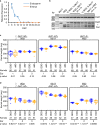Paternal imprinting of dosage-effect defective1 contributes to seed weight xenia in maize
- PMID: 36100609
- PMCID: PMC9470594
- DOI: 10.1038/s41467-022-33055-9
Paternal imprinting of dosage-effect defective1 contributes to seed weight xenia in maize
Abstract
Historically, xenia effects were hypothesized to be unique genetic contributions of pollen to seed phenotype, but most examples represent standard complementation of Mendelian traits. We identified the imprinted dosage-effect defective1 (ded1) locus in maize (Zea mays) as a paternal regulator of seed size and development. Hypomorphic alleles show a 5-10% seed weight reduction when ded1 is transmitted through the male, while homozygous mutants are defective with a 70-90% seed weight reduction. Ded1 encodes an R2R3-MYB transcription factor expressed specifically during early endosperm development with paternal allele bias. DED1 directly activates early endosperm genes and endosperm adjacent to scutellum cell layer genes, while directly repressing late grain-fill genes. These results demonstrate xenia as originally defined: Imprinting of Ded1 causes the paternal allele to set the pace of endosperm development thereby influencing grain set and size.
© 2022. This is a U.S. Government work and not under copyright protection in the US; foreign copyright protection may apply.
Conflict of interest statement
The authors declare no competing interests.
Figures




Similar articles
-
Parent-of-Origin-Effect rough endosperm Mutants in Maize.Genetics. 2016 Sep;204(1):221-31. doi: 10.1534/genetics.116.191775. Epub 2016 Jul 20. Genetics. 2016. PMID: 27440865 Free PMC article.
-
Dynamic and Antagonistic Allele-Specific Epigenetic Modifications Controlling the Expression of Imprinted Genes in Maize Endosperm.Mol Plant. 2017 Mar 6;10(3):442-455. doi: 10.1016/j.molp.2016.10.007. Epub 2016 Oct 25. Mol Plant. 2017. PMID: 27793787
-
Extensive, clustered parental imprinting of protein-coding and noncoding RNAs in developing maize endosperm.Proc Natl Acad Sci U S A. 2011 Dec 13;108(50):20042-7. doi: 10.1073/pnas.1112186108. Epub 2011 Nov 23. Proc Natl Acad Sci U S A. 2011. PMID: 22114195 Free PMC article.
-
Genomic imprinting during seed development.Adv Genet. 2002;46:165-214. doi: 10.1016/s0065-2660(02)46007-5. Adv Genet. 2002. PMID: 11931224 Review.
-
Genomic imprinting and endosperm development in flowering plants.Mol Biotechnol. 2003 Oct;25(2):149-84. doi: 10.1385/MB:25:2:149. Mol Biotechnol. 2003. PMID: 14526125 Review.
Cited by
-
Maize unstable factor for orange1 encodes a nuclear protein that affects redox accumulation during kernel development.Plant Cell. 2024 Dec 23;37(1):koae301. doi: 10.1093/plcell/koae301. Plant Cell. 2024. PMID: 39589935
-
QTL mapping and candidate gene mining of seed size and seed weight in castor plant (Ricinus communis L.).BMC Plant Biol. 2024 Sep 28;24(1):885. doi: 10.1186/s12870-024-05611-6. BMC Plant Biol. 2024. PMID: 39342119 Free PMC article.
-
High- or Low-Yielding F2 Progeny of Wheat Is Result of Specific TaCKX Gene Coexpression Patterns in Association with Grain Yield in Paternal Parent.Int J Mol Sci. 2024 Mar 21;25(6):3553. doi: 10.3390/ijms25063553. Int J Mol Sci. 2024. PMID: 38542529 Free PMC article.
-
KILing in the name of embryonic growth: KIL transcription factors drive cell death in the maize endosperm.Plant Cell. 2025 Jun 4;37(6):koaf133. doi: 10.1093/plcell/koaf133. Plant Cell. 2025. PMID: 40397708 Free PMC article. No abstract available.
-
The conservation of allelic DNA methylation and its relationship with imprinting in maize.J Exp Bot. 2024 Feb 28;75(5):1376-1389. doi: 10.1093/jxb/erad440. J Exp Bot. 2024. PMID: 37935439 Free PMC article.
References
-
- Denney JO. Xenia includes metaxenia. HortScience. 1992;27:722–728. doi: 10.21273/HORTSCI.27.7.722. - DOI
Publication types
MeSH terms
LinkOut - more resources
Full Text Sources

